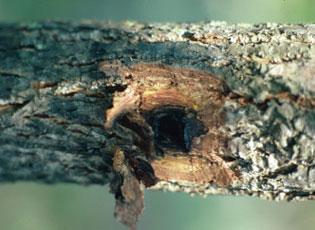Ophiognomonia clavigignenti-juglandacearum (Nair, Kostichka, & Kuntz) Broders & Boland (Broders and Boland 2011)
Butternut canker
Formerly known as Sirococcus clavigignenti-juglandacearum
Unknown, possibly Asia (Furnier et al. 1999)
First detected in 1967, but may have been present before then (Farlee et al. 2010)
Unknown (Ostry et al. 2004)
Lethal disease of butternut trees (Juglans cinerea) (Farlee et al. 2010)
Northeastern and Midwestern U.S.

Butternut canker symptoms
Photo by USDA, FS, Northeastern Area
Find more images
Distribution / Maps / Survey Status
All Resources
Selected Resources
The section below contains highly relevant resources for this species, organized by source.
Partnership
International Government
State and Local Government
Academic
Broders, K.D., and G.J. Boland. 2011. Reclassification of the butternut canker fungus, Sirococcus clavigignenti-juglandacearum, into the genus Ophiognomonia. Fungal Biology 115(1):70-79.
Farlee, L., K. Woeste, M. Ostry, J. McKenna, and S. Weeks. 2010. Conservation and Management of Butternut Trees [PDF, 717 KB]. Purdue University Extension. Publication FNR-421-W.
Furnier, G.R., A.M. Stolz, R.M. Mustaphi, and M.E. Ostry. 1999. Genetic evidence that butternut canker was recently introduced into North America. Canadian Journal of Botany 77(6):783-785.
Ostry, M.E. and K. Woeste. 2004. Spread of butternut canker in North America, host range, evidence of resistance within butternut populations and conservation genetics. In: C.H. Michler et al. (Eds.), Black Walnut in a New Century, Proceedings of the 6th Walnut Council Research Symposium (General Technical Report NC-243, pp.114-120). St. Paul, Minn.: U.S. Forest Service, North Central Research Station.
